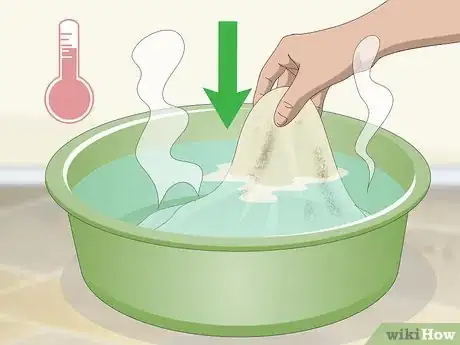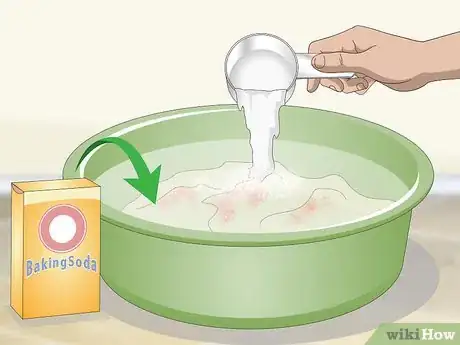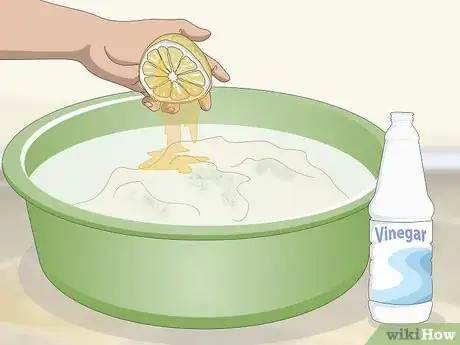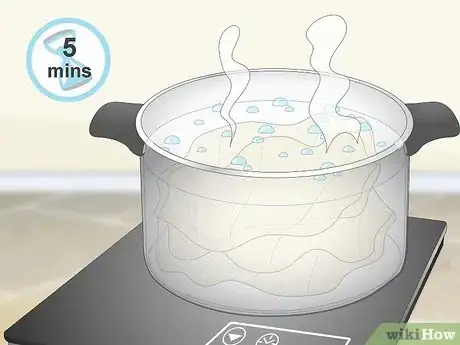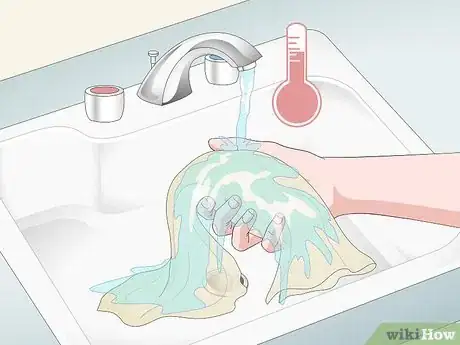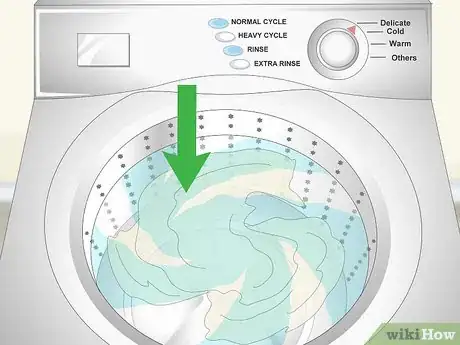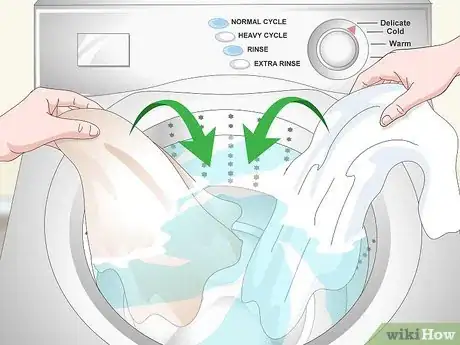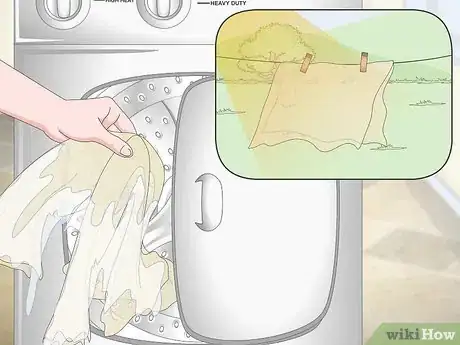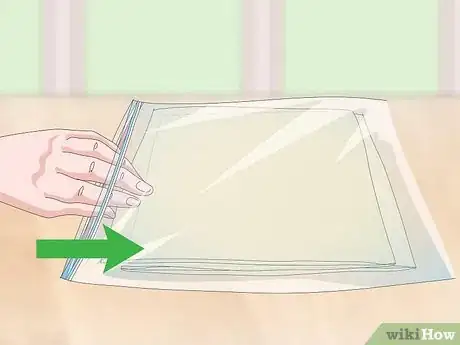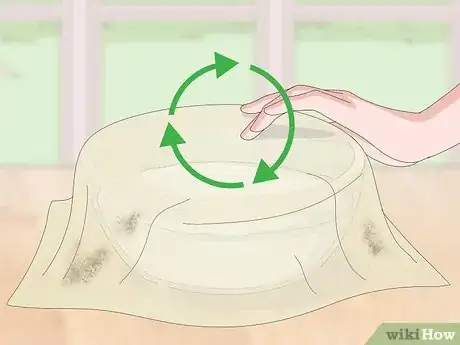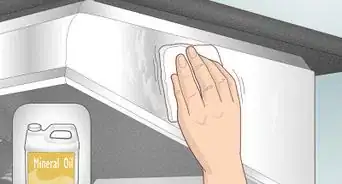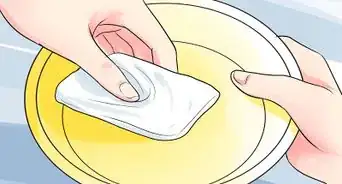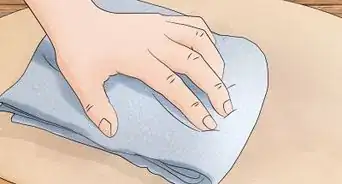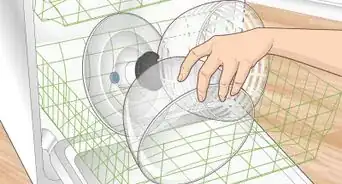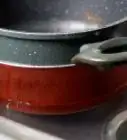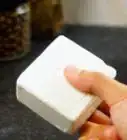This article was co-authored by wikiHow Staff. Our trained team of editors and researchers validate articles for accuracy and comprehensiveness. wikiHow's Content Management Team carefully monitors the work from our editorial staff to ensure that each article is backed by trusted research and meets our high quality standards.
This article has been viewed 138,102 times.
Learn more...
Cheesecloth was once only used to separate curds from whey in cheesemaking. Today, you can use it to make nut milk, prepare greek yogurt, or extract ginger juice, too. With all its various applications, it can be nice to save and reuse cheesecloth instead of buying new sheets every time. If the label on your cheesecloth says one-time use only, you may be able to wash it by hand once or twice, but it will start to break down very soon. If you invest in high-quality cheesecloth, however, you can hand wash it or launder it in the washing machine with your kitchen towels and reuse it nearly indefinitely.
Steps
Washing by Hand
-
1Rinse your cheesecloth in hot water immediately after use. Try to remove as many bits of food as you can. The faster you get to rinsing the cheesecloth, the easier it will be to get food and stains out of it. If you don't have time to rinse it thoroughly right away, put it in a bowl of hot water to soak until you can wash it.[1]
-
2Soak the cheesecloth in a baking soda solution to remove tough debris. If your cheesecloth has bits of food or stains that are difficult to get out with just hot water, add baking soda to a hot water soak. Use ½ cup (90 g) baking soda per 1 gallon (3.75 L) of water. Leave the cheesecloth in the solution for 10-30 minutes, depending on how severe the stains are. Rinse the cheesecloth thoroughly after you soak it.[2]Advertisement
-
3Add white vinegar or lemon juice to the soak water to fade stains and debris. If you have extra stubborn debris or stains on the cheesecloth, add a stain-fighting ingredient to your baking soda soak solution. Simply add 1⁄4 cup (59 ml) of white vinegar or lemon juice per 1 gallon (3.75 L) of hot water along with the baking soda before you soak the cheesecloth.[3]
- You can also spot-treat a stain by dipping a toothbrush into the vinegar or lemon juice and rubbing it against the stain before you soak it.
- Be sure to rinse the cheesecloth very thoroughly after to wash out all the vinegar and lemon juice. They can attract fruit flies if not completely rinsed out of the cheesecloth.
-
4Boil the cheesecloth for 5 minutes for extra sterilization. Bring a large pot of water to boil. Place your cheesecloth inside and let it boil for at least 5 minutes. This will kill any lingering bacteria that may be left in the cheesecloth.[4]
- It's a good idea to boil the cheesecloth every time after you use it, whether you've just rinsed it or if you've soaked it to get rid of stubborn debris.
Laundering in the Washing Machine
-
1Rinse the cheesecloth before you launder it to get rid of food debris. Run the cheesecloth under hot water immediately after you use it so the food stains don't set into the cloth. Hang it to dry until you are ready to put it in the washing machine.
- It's best not to put wet cheesecloth pieces in the laundry basket because it can encourage mold growth.
-
2Wash high-quality cheesecloth in the washing machine. If you have a cheesecloth that's designed for reuse and made from a high-quality knit material (like cotton), you can wash it with other kitchen cloths. Use a detergent meant for delicate fabrics. It should be free of dyes or perfumes, which could damage the cheesecloth or leach out into your food. Use warm or hot water in the wash and cold water rinse with bleach.
- Avoid using a fabric softener when cleaning your cheesecloth. The extra fragrance and softening agents will leave a coating on your cheesecloth and can leach into your food the next time you use it.[5]
- Cheesecloth that's labeled single-use cannot be washed in the washing machine. You may be able to hand wash it and reuse once or twice, but it's better to buy cheesecloth meant for reuse.
-
3Launder muslin with other towels in the washing machine. If you use muslin as an extra-sturdy cheesecloth alternative, you can easily wash it in your washing machine. Add it in the same load with your kitchen or bath towels. Check the label on your detergent to make sure it doesn't contain dyes or fragrances that could contaminate your food the next time you use the muslin.
- Avoid using fabric softener for your muslin, as it could cause buildup on the cloth that can leach into your food.
- The muslin will shrink after you wash it the first time.[6]
- Pick a lightweight unbleached muslin as an easy to clean cheesecloth alternative. Unbleached muslin will have a natural cream color.[7]
- Find muslin at your local fabric store. Tell them you are looking for muslin to use as cheesecloth for straining or squeezing.
Drying and Storing
-
1Dry the cheesecloth in the dryer or outside in the sun. After you've washed your cheesecloth by hand or in the washing machine, put it through a hot cycle in the dryer. You can also dry it outside in the sun if it's hot outside and it can dry quickly. Hang it on a clothesline or drape it over a clean chair in direct sunlight.[8]
-
2Fold and store the cheesecloth in a plastic bag. When the cheesecloth is completely dry, fold it 2 or 3 times until it forms a small square or rectangle. Store it in a cool, dry place in an airtight plastic bag until you are ready to use it again.
-
3Reuse sterilized cheesecloth even if it's stained. Naturally, cheesecloth will get stained sooner or later. If the stain doesn't wash out in the laundry, it won't leach out into your food, either. Be sure to sterilize the cheesecloth by boiling it after you hand wash it or launder it in the washing machine. Dry the cheesecloth before you store it.
- If the stains really bother you, add bleach to your soak water the next time you wash the cheesecloth. Use 1⁄4 cup (59 ml) bleach per 1 gallon (1.75 L) water.
Community Q&A
-
QuestionAre you supposed to wash cheesecloth?
 Drew Hawkins1Community AnswerYes! You can totally wash cheesecloth and reuse it instead of buying new sheets every time you need some. It's also pretty easy to do. If your cheesecloth has bits of food or stains that are difficult to get out with just hot water, add baking soda to a hot water soak. Use ½ cup (90 g) baking soda per 1 gallon (3.75 L) of water. Leave the cheesecloth in the solution for 10-30 minutes, depending on how severe the stains are. Rinse the cheesecloth thoroughly after you soak it. Then, bring a large pot of water to boil. Place your cheesecloth inside and let it boil for at least 5 minutes to kill any lingering bacteria that may be left in the cheesecloth. Allow the cheesecloth to airdry and you're good to go!
Drew Hawkins1Community AnswerYes! You can totally wash cheesecloth and reuse it instead of buying new sheets every time you need some. It's also pretty easy to do. If your cheesecloth has bits of food or stains that are difficult to get out with just hot water, add baking soda to a hot water soak. Use ½ cup (90 g) baking soda per 1 gallon (3.75 L) of water. Leave the cheesecloth in the solution for 10-30 minutes, depending on how severe the stains are. Rinse the cheesecloth thoroughly after you soak it. Then, bring a large pot of water to boil. Place your cheesecloth inside and let it boil for at least 5 minutes to kill any lingering bacteria that may be left in the cheesecloth. Allow the cheesecloth to airdry and you're good to go! -
QuestionCan you wash cheesecloth in the washing machine?
 Drew Hawkins1Community AnswerYou actually can! Washing cheesecloth is super effective and super simple. If you have a cheesecloth that's designed for reuse and made from a high-quality knit material (like cotton), you can wash it with other kitchen cloths. Use a detergent meant for delicate fabrics. It should be free of dyes or perfumes, which could damage the cheesecloth or leach out into your food. Use warm or hot water in the wash and cold water rinse with bleach. After you've washed your cheesecloth by hand or in the washing machine, put it through a hot cycle in the dryer. You can also dry it outside in the sun if it's hot outside and it can dry quickly. Hang it on a clothesline or drape it over a clean chair in direct sunlight.
Drew Hawkins1Community AnswerYou actually can! Washing cheesecloth is super effective and super simple. If you have a cheesecloth that's designed for reuse and made from a high-quality knit material (like cotton), you can wash it with other kitchen cloths. Use a detergent meant for delicate fabrics. It should be free of dyes or perfumes, which could damage the cheesecloth or leach out into your food. Use warm or hot water in the wash and cold water rinse with bleach. After you've washed your cheesecloth by hand or in the washing machine, put it through a hot cycle in the dryer. You can also dry it outside in the sun if it's hot outside and it can dry quickly. Hang it on a clothesline or drape it over a clean chair in direct sunlight. -
QuestionIs muslin the same as cheesecloth?
 Drew Hawkins1Community AnswerMuslin isn't quite the same as cheesecloth, but you can use it for many of the same purposes. Think of muslin as an extra-sturdy cheesecloth alternative. Because it's stronger, you can also wash muslin in your washing machine and reuse it. Add it in the same load with your kitchen or bath towels. Check the label on your detergent to make sure it doesn't contain dyes or fragrances that could contaminate your food the next time you use the muslin. Avoid using fabric softener for your muslin, as it could cause buildup on the cloth that can leach into your food. After you wash it, you can dry the muslin in your dryer or hang it up to airdry in the sun. Once it's dry, you can store it until you need to use it.
Drew Hawkins1Community AnswerMuslin isn't quite the same as cheesecloth, but you can use it for many of the same purposes. Think of muslin as an extra-sturdy cheesecloth alternative. Because it's stronger, you can also wash muslin in your washing machine and reuse it. Add it in the same load with your kitchen or bath towels. Check the label on your detergent to make sure it doesn't contain dyes or fragrances that could contaminate your food the next time you use the muslin. Avoid using fabric softener for your muslin, as it could cause buildup on the cloth that can leach into your food. After you wash it, you can dry the muslin in your dryer or hang it up to airdry in the sun. Once it's dry, you can store it until you need to use it.
Things You'll Need
Washing by Hand
- Baking soda
- White vinegar or lemon juice
- Pot
- Hot water
Laundering in the Washing Machine
- Gentle detergent
- Bleach
Drying and Storing
- Plastic bag
- Clothesline
References
- ↑ https://lexiscleankitchen.com/cold-brew-iced-coffee/
- ↑ https://lexiscleankitchen.com/cold-brew-iced-coffee/
- ↑ https://lexiscleankitchen.com/cold-brew-iced-coffee/
- ↑ http://blog.cheesemaking.com/sanitizing-tools-equipment/
- ↑ https://lexiscleankitchen.com/cold-brew-iced-coffee/
- ↑ https://www.vietworldkitchen.com/blog/2012/03/muslin-is-the-better-cheesecloth.html
- ↑ https://www.vietworldkitchen.com/blog/2012/03/muslin-is-the-better-cheesecloth.html
- ↑ https://lexiscleankitchen.com/cold-brew-iced-coffee/
About This Article
Whether you wash cheesecloth by hand or in a washing machine, it’s important that you do it properly so it doesn’t break down. To wash it by hand, try to remove as many bits of food as you can from the cloth and soak it in a solution of 1 gallon of water and ½ cup of baking soda for 10-30 minutes. If there are stains, add 1⁄4 cup of white vinegar to the solution while it soaks. When it’s finished soaking, boil the cloth in a pot of water to sterilize it. If you want to wash the cloth in a washing machine, prepare it by rinsing the cheesecloth under hot water to remove debris. Then, place it in your washing machine, add detergent made for delicate fabrics, and wash it on a gentle cycle. Once it’s clean, you can dry it in your dryer or hang it up to air dry. To learn how to store cheesecloth, keep reading!
